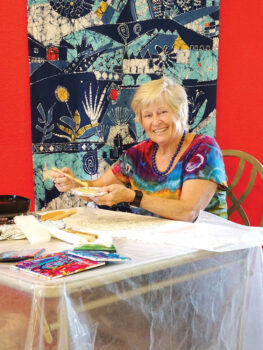
Greta von Wrangel carefully applies wax in a detailed pattern as she creates a batik design. (Photo by LaVerne Kyriss)
LaVerne Kyriss
Greta von Wrangel is a long-time textile artist who started learning batik when her mother took a class in 1968 to learn the technique involved in using layers of wax resist and multiple dye baths to create intricately designed, often multi-colored fabric.
“I designed a batik featuring one of the iconic Victorian San Francisco homes. I called it “Blue House” and it sold. From then on, I read every book about batik I could get my hands on and began experimenting,” she said. “We first started melting the wax on the stove, but that was a fire hazard. You must carefully control the wax temperature so as to not reach the flash point. Besides it’s not really convenient to work right next to the stove,” she laughed.
Eventually, von Wrangel began teaching classes at Green River Community College in a Seattle suburb and showing her work. “I’m mostly self-taught but learned so much from my mother. She was an amazing artist in many mediums. She was one of the founding hot glass artists from the University of Washington,” von Wrangel said. “We always worked with fiber. I was born in Estonia but we moved to Poland. When I was four, I learned to knit because we had sheep. We used berries and other items to dye the wool.”
Today, von Wrangel uses a small electric skillet where she can precisely control the temperature to match the type and mix of wax she’s using. “I just need an electric outlet and a table on which to place the fabric on which I’m working.”
Batik is a centuries-old traditional form of dyeing cloth. The art form reached its pinnacle in Indonesia, but it’s found across many parts of the world. “I like to create really big wall hangings. I often use designs drawn from nature, but sometimes also use abstract patterns. My work is intricate and I often create pieces that involve four or five dye baths. Understanding the color wheel and how the colors will react to another layer of dye takes a lot of experimentation and practice,” von Wrangel explained.
“We all know that yellow and blue, when mixed together, make green. But to get vivid colors when dyeing fabric, you must use a yellow dye bath first, followed by blue, and you must be very careful about the intensity of the blue so it doesn’t overpower the yellow,” she detailed. “And before you get to the blue bath, you need to dry your yellow fabric completely and then apply wax to any areas you want to remain yellow. Working in batik means you have to think about your design in reverse, and work from light to dark. You also are working on the entire piece and not just one section when you apply the color.”
When not creating batiks, von Wrangel is also experimenting with ice dyeing, which is another technique for applying dye to fabrics. It grew out of the Japanese technique of tie dying called Shibori. Small, usually round objects are tightly tied in the fabric using rubber bands or waxed thread or cording. These repel the dye colors and create patterns. The prepared fabric is then placed in a tub, covered with ice and then the powdered dyes are added to the top. As the ice slowly melts over 24 hours, the dye compounds slowly work their way into the fabric creating intricate patterns and color combinations.
“I use my knowledge of colors to determine how to place the dye powders so they will mix in pleasing ways and not end up with muddy browns,” she noted. “It’s a very creative process that can’t be totally controlled. It’s always a surprise to see what comes out. It’s very unpredictable.”
“Whatever medium you choose, always use the best quality materials. Who wants to spend hours fighting against your tools or supplies to get the effect you’re seeking?” she reflected. “And take a class to explore new areas. You not only learn from the instructor, you learn from the other participants and you get energy from the group. You don’t know how good you are until you try it,” she summed up.
